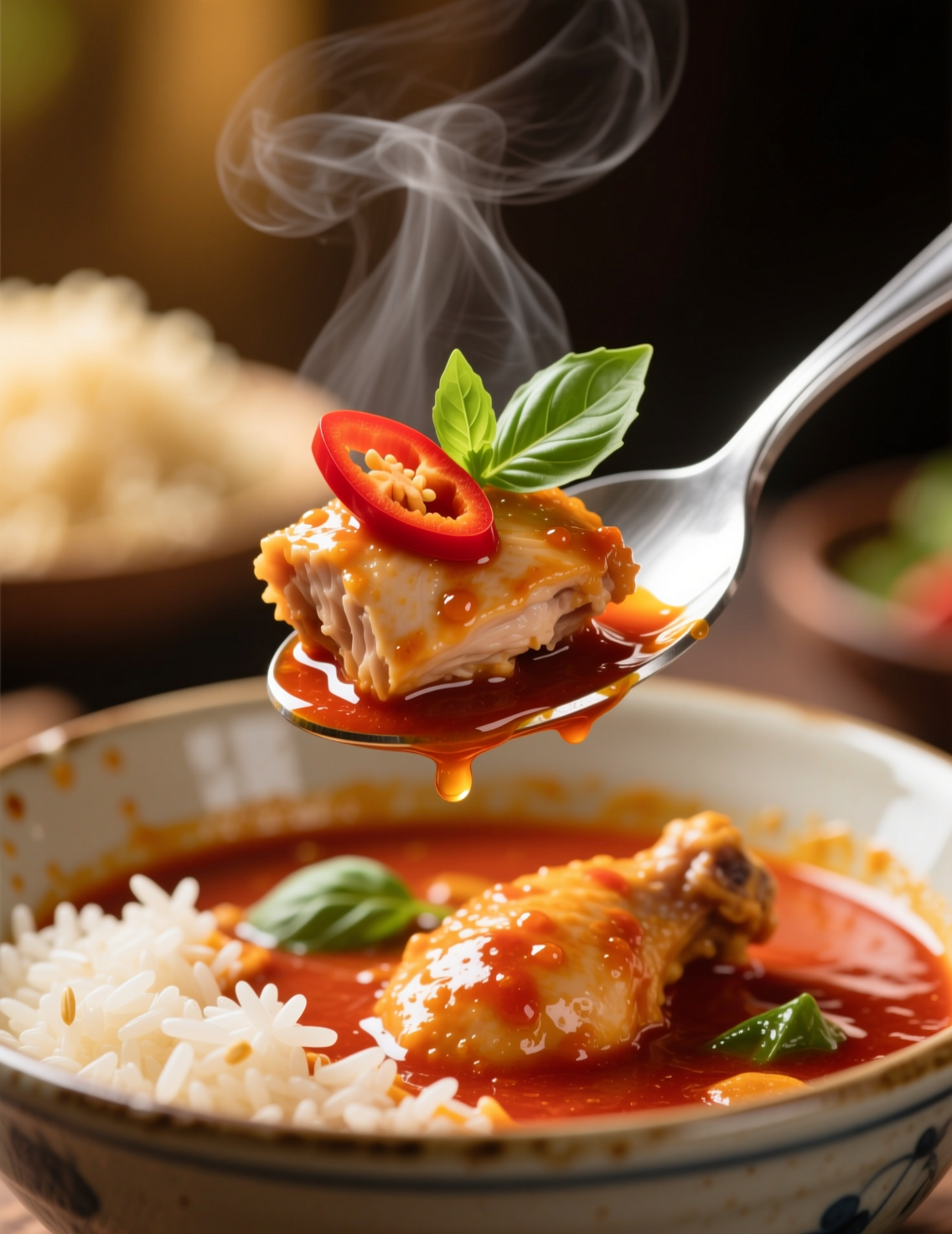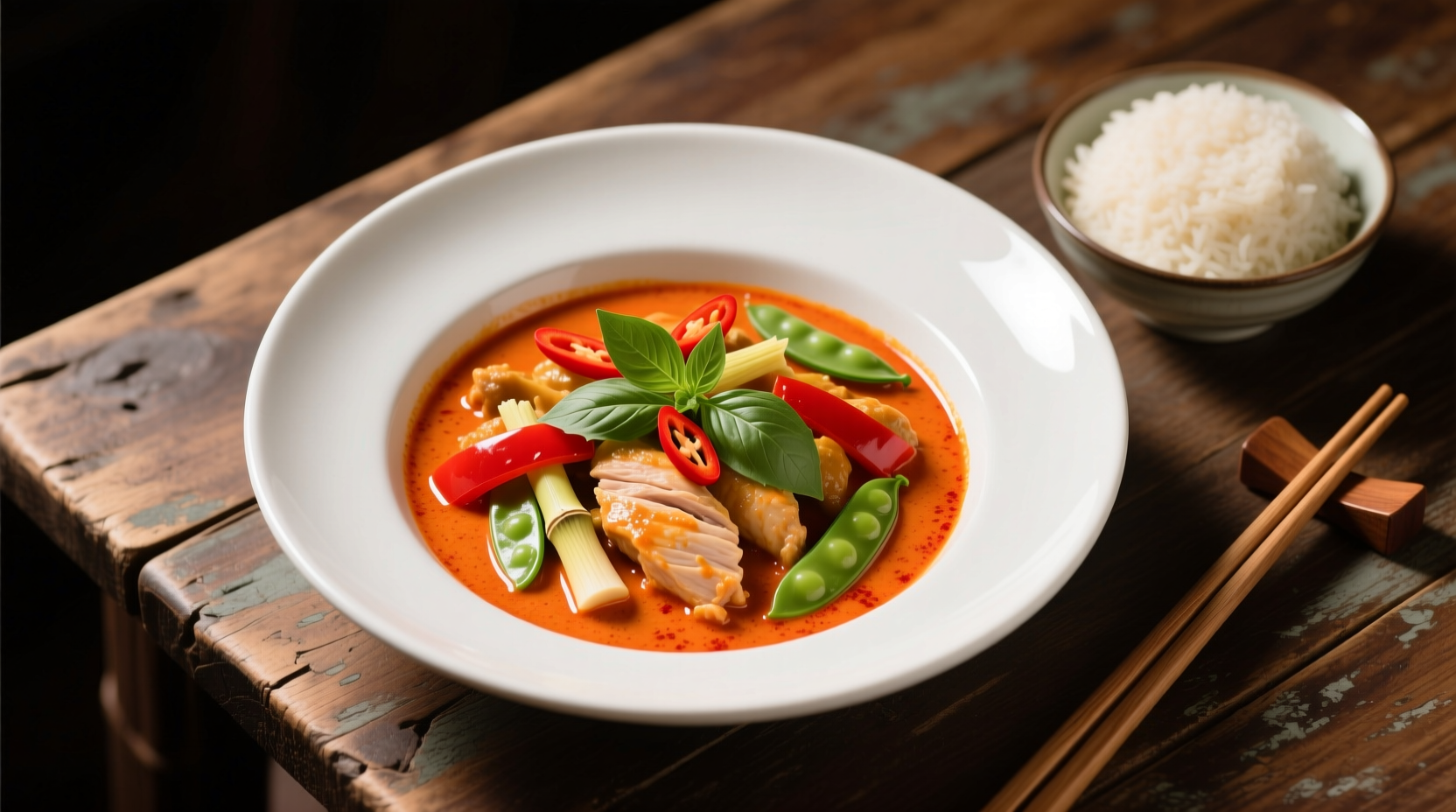There are dishes that people cook to just fill a plate, and then there are dishes that stir something deeper. Thai red curry chicken belongs firmly in the second camp. It’s comforting, complex, and surprisingly straightforward once you understand the rhythm of the dish. This article unpacks everything about making an easy Thai red curry chicken recipe for 4 servings, not just as a casual home meal but with the eye of a professional chef.
Why Thai Red Curry is More Than Just Dinner
Thai curries sit at a fascinating crossroad of history, culture, and technique. Red curry, in particular, carries bold flavors rooted in traditional Thai cuisine but has adapted itself beautifully into global kitchens. Its base of red curry paste—rich in red chilies, lemongrass, garlic, galangal, and kaffir lime—makes it fragrant and fiery at once.
What makes it so popular isn’t only the spice. It’s the balance. Thai cooking, unlike many cuisines, aims for harmony: spicy, sweet, sour, and salty playing together like musicians who somehow never step on each other’s toes.
Key Ingredients That Define Authentic Thai Red Curry
If you strip the dish down, four elements build its backbone. First, the red curry paste. This paste is where flavor either sings or collapses. Store-bought pastes from brands like Mae Ploy or Maesri are commonly used in restaurants worldwide because they’re consistent and reliable.
Second, coconut milk. Don’t fall into the trap of low-fat versions. Real Thai curry needs full-fat coconut milk to carry both flavor and texture. According to a 2020 study on culinary fats and emulsions, coconut milk’s natural balance of fat and water makes it exceptional for building creamy sauces without separation.
Third, protein. Chicken thighs are superior to breasts in this dish. They hold moisture better and absorb flavors more deeply during simmering. And lastly, balance. Palm sugar, fish sauce, and lime juice are not extras—they’re the hidden levers you adjust to steer the dish’s harmony.

Recipe: Easy Thai Red Curry Chicken (4 Servings)
Ingredients
- 2 tablespoons red curry paste (adjust to heat preference)
- 1 pound chicken thighs, cut into bite-sized chunks
- 1 can (14 oz) full-fat coconut milk
- 1 tablespoon vegetable oil
- 1 tablespoon fish sauce
- 1 teaspoon palm sugar (or brown sugar if unavailable)
- 1 red bell pepper, sliced thin
- 1 zucchini, halved lengthwise and sliced
- 1 small onion, sliced
- 4 kaffir lime leaves (optional but traditional)
- 1 tablespoon fresh lime juice
- Fresh Thai basil for garnish
- Steamed jasmine rice, to serve
Instructions
Heat the oil in a heavy pan or wok over medium heat. Add the curry paste and stir for 1–2 minutes until fragrant. This blooming step unlocks the paste’s full potential.
Pour half of the coconut milk and stir until the paste fully dissolves. Let it bubble gently, and you’ll see the red oil rise to the surface. That’s a sign the base is ready.
Add the chicken and stir until coated. Pour in the rest of the coconut milk, fish sauce, and sugar. Drop in kaffir lime leaves if you have them—they release a floral brightness impossible to mimic.
Simmer for 15 minutes, stirring occasionally. Add bell pepper, zucchini, and onion. Cook for 5–7 more minutes until vegetables soften but still hold shape. Finish with lime juice.
Serve hot, topped with Thai basil, alongside jasmine rice. The curry should be slightly thick but pourable, with a glossy sheen from the coconut.
Professional Notes on Technique
One detail chefs often overlook: when you fry the curry paste, don’t rush. The paste needs that quick dance with oil before coconut milk joins the party. If you skip it, the curry tastes flat. Think of it like roasting coffee beans—heat releases hidden layers.
Another note: balance is not one-size-fits-all. In Thailand, curries are often adjusted at the table with a squeeze of lime, a spoon of fish sauce, or even a sprinkle of sugar. Professionals should encourage diners to tweak their bowls. Cooking ends when the dish leaves the pan, but flavor finishes in the mouth.
The Science Behind Coconut Milk in Curries
Food scientists highlight that coconut milk contains emulsifiers that stabilize sauces naturally. When simmered gently, coconut milk forms a stable emulsion with oil, preventing the dreaded split sauce. A study from Food Hydrocolloids Journal in 2018 confirmed that coconut fat droplets stabilize best under moderate heat, which explains why high-heat boiling often ruins curries. Professionals must respect the ingredient’s science if they want consistent results.
Common Mistakes and How to Dodge Them
One frequent slip is using too much curry paste. More paste doesn’t always mean more flavor—it just creates heat without balance. Two tablespoons for four servings is standard; adjust slightly, but don’t overwhelm the dish.
Another mistake: overcooking vegetables. Bell peppers and zucchini should never collapse into mush. They need structure to contrast with tender chicken and silky sauce.
And perhaps the biggest sin: substituting low-fat coconut milk. It breaks, curdles, and lacks depth. Professional kitchens rarely touch it, and neither should you.
Variations Across Regions and Restaurants
While the base recipe remains stable, Thai red curry is remarkably versatile. Some chefs swap chicken for duck, adding richness that pairs beautifully with lychee or pineapple for sweetness. Seafood versions, with prawns or squid, adjust cooking times drastically—protein goes in late to avoid toughness.
In Northern Thailand, red curries sometimes carry more herbs and less coconut, reflecting regional preferences. Meanwhile, in Western kitchens, chefs often dial down spice or add extra vegetables like carrots and snap peas to appeal to broader diners.
How Professionals Plate Thai Red Curry
Plating Thai curry may sound trivial, but in fine dining, presentation elevates perception. Restaurants often serve curry in shallow bowls with a neat mound of jasmine rice on the side. Fresh Thai basil leaves add both aroma and elegance. Some sprinkle microgreens or chili threads for dramatic effect.
Contrast is key. White rice against the deep red curry provides visual clarity, while green basil pops against the sauce. Diners eat with eyes first, and curry benefits immensely from thoughtful plating.
Addressing Misconceptions
Many people assume all Thai curries are blisteringly hot. In truth, red curry is milder than green curry and often more approachable. Heat levels depend more on the brand of curry paste and the cook’s adjustments.
Another misconception: fish sauce makes food taste fishy. Used correctly, fish sauce adds umami depth rather than oceanic tang. Professional chefs often compare it to Parmesan cheese—it stinks raw but transforms cooked dishes.
Nutritional Insights
One serving of Thai red curry chicken with rice averages around 450–500 calories. The bulk comes from coconut milk, which is calorie-dense but also provides medium-chain triglycerides (MCTs), shown in studies to metabolize faster than long-chain fats. Chicken thighs bring protein and iron, while vegetables add fiber and vitamins.
For professionals catering to health-conscious diners, portion control and rice pairing matter more than ingredient substitution. Cutting coconut milk or sugar only sacrifices flavor integrity.
The Growing Popularity of Thai Red Curry in Global Cuisine
According to 2023 data from the National Restaurant Association, Thai curries ranked among the top 10 global flavors influencing American menus. Delivery platforms also report spikes in Thai curry orders, particularly red curry, during colder months when diners crave warmth.
This surge reflects broader culinary trends: comfort foods with international roots. Thai red curry ticks all the boxes—affordable ingredients, bold flavors, and adaptability to different proteins and diets.
Actionable Tips for Professionals
- Source curry paste wisely. Imported Thai brands outperform generic supermarket jars.
- Always bloom paste in oil before adding liquids.
- Use full-fat coconut milk only, preferably canned, not boxed.
- Adjust balance at the end with lime juice, sugar, or fish sauce.
- Plate thoughtfully for visual and aromatic impact.
Conclusion
Easy Thai red curry chicken for 4 servings is not just a recipe—it’s a lesson in balance, technique, and respect for ingredients. For chefs and culinary professionals, it offers an opportunity to showcase authentic flavors while still adapting to diverse diners.
When done right, this dish is a harmony of creamy coconut, bold chili, and fragrant herbs that feels both exotic and familiar. Remember: Thai cooking thrives on balance, and as any skilled cook knows, balance is not found—it’s made, spoon by spoon, until the dish finally sings.
FAQs
What is the best chicken cut for Thai red curry?
Chicken thighs are best since they stay tender and absorb more flavor than breasts.
Can I use low-fat coconut milk?
No, it breaks easily and lacks the creamy depth of full-fat coconut milk.
How spicy is Thai red curry?
It’s moderately spicy, milder than green curry, but heat varies by paste brand.
Can I substitute palm sugar?
Yes, light brown sugar works fine though palm sugar gives more authentic depth.
Do I need kaffir lime leaves?
They’re optional, but they add a fragrant citrus note that elevates the curry.
How long should I cook the vegetables?
Only 5–7 minutes so they soften slightly but still keep their shape.
What is the role of fish sauce in curry?
It adds umami depth, similar to how Parmesan enhances Italian dishes.
Can I make this curry ahead of time?
Yes, it reheats well but add fresh basil and lime juice right before serving.
What rice pairs best with Thai red curry?
Steamed jasmine rice is traditional and balances the curry’s richness perfectly.
Is red curry paste store-bought or homemade better?
Homemade offers customization, but trusted Thai brands give consistency and reliability.

Mariana is a passionate home cook who creates delicious, easy-to-follow recipes for busy people. From energizing breakfasts to satisfying dinners and indulgent desserts, her dishes are designed to fuel both your body and hustle.
When she’s not in the kitchen, she’s exploring new flavors and dreaming up her next recipe to share with the Foodie Hustle community.

